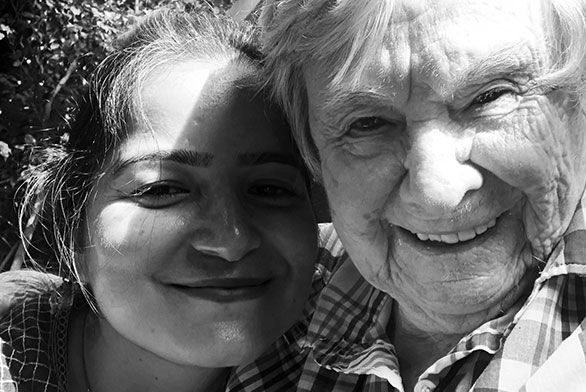From Adam Smith to the 'Mahābhārata,' Dimple Kaul (AGI21, EC25) Is on a Mission to Read the World's Greatest Philosophers
July 11, 2024 | By Kayleigh Steele (AGI22, EC25)
Since 1967, the St. John’s College Graduate Institute has welcomed individuals from all walks of life, united in their quest to learn from history’s most influential writers, philosophers, mathematicians, and scientists. Spring 2024 was one for the books, with 118 scholars enrolled in the Annapolis program and 87 in Santa Fe; together, they comprise the GI’s largest headcount in decades. Among their ranks are teachers and lawyers, artists and musicians, retired professionals and investment bankers, part-time and full-time students. Some live and work nearby; others come from far away or do the program remotely through the Low-Residency Program.
In our Graduate Institute Student Spotlight, we profile cohort members in Annapolis and Santa Fe. By highlighting their wide-ranging interests and backgrounds, we show that just like there is no one-size-fits-all analysis of a great book, there’s no one-size-fits-all GI student.
Dimple Kaul (AGI21, EC25) is the youngest student in St. John’s College history—in a manner of speaking, anyway.

In 2017, Kaul, frustrated by the corporate grind, had just submitted her resignation from a lucrative marketing career when a major accident propelled her into a new life. Crossing a busy intersection in Mumbai, Kaul was struck by a vehicle running a red light, leaving her with injuries that would take months to heal—and time to reflect on what was most important to her.
Today, Kaul is fully immersed in study of great books and is currently completing her second St. John’s master’s degree in Eastern Classics. “This is my second life,” she says. “I’m seven years old!”
In her first life, unrest in Kaul’s childhood left little room to focus on anything but practical matters. Religious terrorism uprooted her family from their indigenous homeland in the Kashmir Valley when she was 12, rendering them refugees in their own country. She soon discovered poetry, which helped her intuitively channel her grief. But as she entered adulthood, practicality informed her path. Entering a stable industry would ensure she would not become a burden on her parents. “It was like I had blinders like a horse,” she explains. A 15-year career in telecommunications marketing offered her security and independence, but “after I joined the corporate world,” she recalls, the poetry “all dried up.”
Already having resolved in 2017 to quit her job and pursue higher education, Kaul’s accident provided further motivation. “I thought of being flung into the air,” she says, “as if the universe was telling me, ‘You are in some freaking comfort zone and you need to move.’ It actually felt as if I was being shoved.” So, in June 2019, Kaul arrived in Annapolis to begin the Master of Arts in Liberal Arts (MALA) program on a colleague’s recommendation. She had not spent much time before in the United States, but she instantly found echoes of home in her new city. A small waterfront park downtown conjured images of Kashmir, and the squirrels on campus reminded her of a tale from the Ramayana in which a squirrel, in its own small way, helps the god Rama build a bridge.
With encouragement from her tutors, Kaul soon found her stride at the seminar table despite having little familiarity with classical texts. The GI’s Mathematics and Natural Science segment came easily to her, and she was wowed by Adam Smith’s 1759 book The Theory of Moral Sentiments on modern moral philosophy: “I just got into it, and then I never got out!”
Smitten with studying great books and unable to find a similar program in India that studied Eastern texts using the St. John’s-style pedagogy she loved, Kaul next made her way to Santa Fe to begin the Master of Arts in Eastern Classics program. This time around, she had real-life perspective to offer her classmates while encountering the Program’s Indian works. (Whereas the culture portrayed in Greek classics like the Iliad is no longer practiced in Greece today, she says, “As a Hindu, I’m still alive and I’m practicing this culture.”)
While she was already familiar with many Indian texts in the curriculum, revisiting them has “cleared a lot of cobwebs” from her head; reading the Ramayana from start to finish showed her where she had previously encountered abridged or creative interpretations of the story and allowed her time to tackle some longstanding misgivings about how the gods Rama and Sita are depicted—deities who occupy a place in Kaul’s life beyond the book’s pages. Although her colleagues at the seminar table tend to approach course materials with an academic mindset, Kaul has been delighted by their open-mindedness and respect while discussing spiritual texts from her own tradition.
Now, Kaul says, with a formal graduate background in the great books, she feels a new confidence in her role as the Director of Academic Programs at INDICA (INDIC Academy), an institute for Indian Knowledge Systems (IKS). As the head of INDICA Courses, the academic division of INDICA, she advances the institute’s mission of fostering health, happiness, and harmony through the wisdom of Indic heritage. Her creative energies are also flowing again: in the past seven years, Kaul has published two anthologies of poems, incubated seven book projects, and started a blog hosted by The Times of India, India’s largest circulating English daily newspaper. Currently, she is working on three new book projects, all within the domain of IKS.
Looking towards the future, Kaul hopes to continue drawing from her St. John’s experience to create a new program that brings ancient knowledge—much of which was lost in the popular consciousness after British colonialism—back to the mainstream; she believes that texts like the Mahābhārata can offer rich lessons for today’s leaders in public policy, administration, economics, and more. “Sounds very lofty,” she admits. “But, you know, with divine guidance and blessings, I might achieve [it].”

